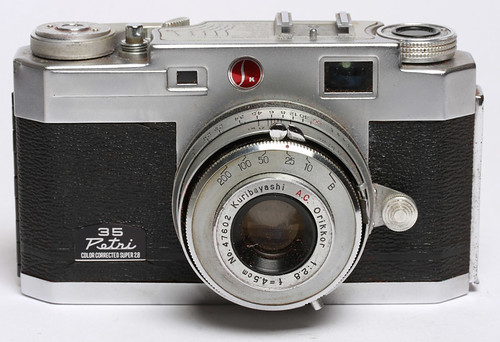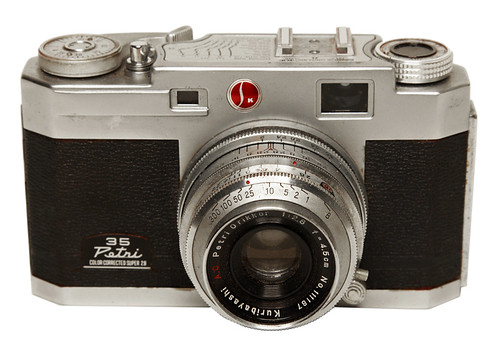Petri Color Corrected Super

|
| Advertisement for the Petri 35 in the Japanese magazine Photo Art (フォトアート), October 1955. Scan by rebollo_fr (Image rights) |
A series of 35mm coupled rangefinder cameras made by Kuribayashi (soon to be renamed Petri) carry a badge on the front right-hand side of the body including the phrase Color Corrected Super. There is a common design to all the cameras, and a progression in design through the series. Although it is not at all clear that Color Corrected Super was the model name of any of them, it is as good a collective name for the series as any.
Contents
Petri 35
The Petri 35 (this model name is clear from the user's manual[1], and 'Petri 35' appears on the badge, together with 'color corrected super') was Kuribayashi's first 35mm rangefinder, in 1954. The camera has Petri's 45mm Orikkor lens, a coated Tessar type, and their Carperu shutter. It is likely that the specification improved with time: McKeown states that some examples have an f/3.5 lens[2], but the manual only mentions an f/2.8. Again, McKeown gives the range of speeds as only 1/10 - 1/200 second, plus 'B', while the manual states that the shutter gives speeds from 1 to 1/300 second. The advertisement reproduced to the right shows a camera according to the specification described by McKeown.
The shutter described in the manual has X-synchronisation, with a PC socket and cold shoe; it is cocked automatically by the film advance, which is lever-wind. In early versions such as the camera pictured below left, and in the advertisement, the cocking lever is exposed on the lens barrel and cocked via a linkage from the advance lever. In all later models of course the linkage was concealed within the lens barrel. McKeown lists developments of the Petri 35, which he names the Petri 35X (1955) and Petri 35MX (1955-8); these suffixes presumably refer to improvements in the shutter (flash synchronisation), so may account for the variations noted.
The coupled rangefinder is combined with the viewfinder, so the camera has two small rangefinder/viewfinder windows on the front of the top housing, and just one eyepiece.
For the company's first 35mm rangefinder, it is well-specified; very similar indeed to the Yamato Pax M2 or M3 of about the same time.
|
| ||||
| Earlier and later Petri 35. Both have an f/2.8 lens; the earlier camera with shutter to 1/200 second, has an exposed cocking linkage; the later one has a concealed cocking linkage and shutter to 1/300 second. Note the exposure guide on the top plate. Images by Rick Soloway (Image rights) | |||||
Petri Automate
The Petri Automate[3] was made from 1956; i.e. it was introduced alongside the Petri 35, as a superior version of it. It has an f/1.9 Orikkor, and the shutter now gives speeds from 1 to 1/500 second plus 'B', and has a self-timer. The top housing is slightly restyled; the glass of the rangefinder window is much larger, although behind it, the metal frame of the rangefinder spot itself is not significantly changed. The film rewind knob has been replaced with a folding crank.

|
| Petri Automate Photo by Marv Olsen (Image rights) |
Petri 2.8, Petri 2.0 and Petri 1.9
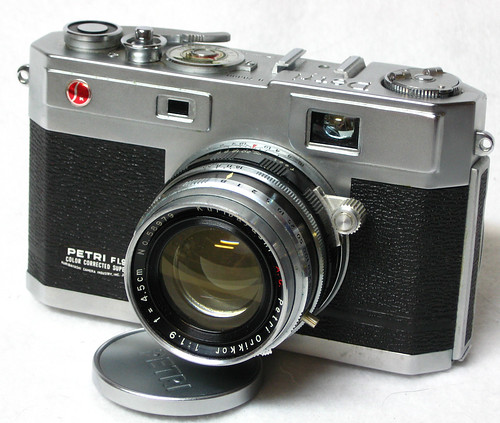
|
| Petri 1.9; note the different design of the controls to the f/2.8 model. image by Mark O'Brien (Image rights) |
The Petri 2.8 and Petri 2.0 were introduced in 1957, according to McKeown,[2] and the Petri 1.9 in 1958. McKeown calls these models the Petri 35 2.8, etc. but the model names are given as 'Petri 2.8' and 'Petri 1.9' (and even written in words as 'Petri One-Point-Nine') in the user's manuals.[4] The f/1.9 camera (particularly the controls on the top plate) is slightly more stylish, like the Automate. McKeown states that the f/2.0 model was introduced to fill an apparent gap between the high- and low-specification models.
Again, the specification may have developed with time. McKeown states that the shutter on all these models is now a Copal, giving speeds up to 1/500 second; however, the manual for the f/2.8 camera still describes a Carperu with a maximum speed of 1/300. McKeown likely means that the shutter is a "Copal-type", as the Carperu is a clone of a typical Copal shutter mechanism. The manual for the f/1.9 camera refers to the shutter only as an MXV shutter, which indicates the faster version of the Carperu with a top speed of 1/500 and also including a self-timer function. The f/2.8 lens is still a Tessar type, but the f/1.9 is a six-element lens (of four groups).
All three models have the same small rangefinder window as the original Petri 35. All have a folding crank for film rewind. All models have a shutter release surround that can be screwed off to permit use of an external-thread style shutter release cable.
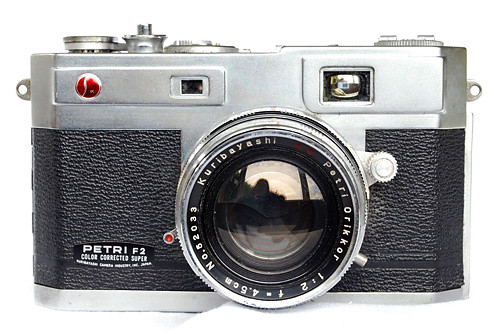
|
| Petri 2.0 image by eBayer aoraki-nz (Image rights) |
Petri 'Color Super' series
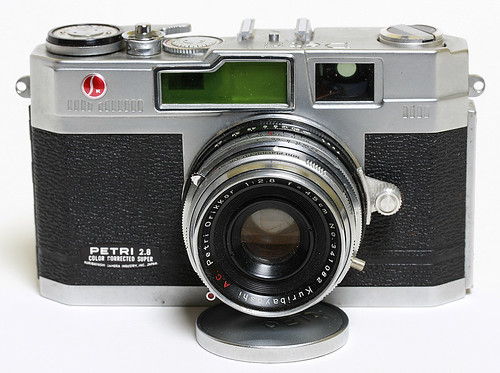
|
| Petri 2.8 Color Super, with bright-line viewfinder image by Rick Soloway (Image rights) |
The models above were replaced with the so-called Petri 2.8 Color Super (1958), Petri 1.8 Color Super (1959) and Petri 1.9 Color Super (1960). These cameras are called 'Color Super' by McKeown,[2] and elsewhere, but no Petri document has yet been seen using this name. The Petri manual for the 2.8 version, for example, simply calls the camera the Petri 2.8 throughout the manual, making no distinction in name from the previous Petri 2.8 model.
The improvements in this range include an all-new wide angle viewfinder with a parallax-corrected brightline frame in the viewfinder, which the manual calls the "Green-O-Matic System". The brightline frame (called both the "Petri-Gold" frame and the "Gold Gleam" frame in the manual) is illuminated via a green glass window (called "Green Crown" glass by Petri) in the front of the top housing, which also covers the rangefinder window (once again, the specification must have been changed; McKeown shows an example of the f/1.9 camera in which only the brightline panel is covered with green glass, not the RF spot).
The styling of the three models is very similar, whereas in the preceding series, the model with the faster lens was more generally better-specified. As with the previous series, all models in this series have a shutter release surround that can be screwed off to permit use of an external-thread style shutter release cable.
Some versions (perhaps early versions?) of this model use the Petri Carperu MX shutter with speeds to 1/300th second, while other versions (later?) use the Petri Carperu MXV shutter, which adds a self-timer function and includes a top speed of 1/500th second. The shutter designation almost certainly indicates the two flash synchronization types ("M" for flashbulbs and "X" for electronic flash), and the presence of a self-timer, which is often labeled "V" on cameras of that era[5].
For modern users of this camera, please note that the flash synch lever MUST be set to "X" when using the self-timer function, as is common to leaf shutters of that era. Using the self timer with the flash synch lever set to "M" may result in damage to the shutter mechanism. A flashbulb can still be used with the "X" setting as long as the shutter speed is 1/30th second or slower.
The Petri E.Bn of 1960 is simply a Color Super with an uncoupled selenium meter fitted to it, according to McKeown. After this, Petri began the Petri 7 series of rangefinders, along the lines of the Canonet, with selenium meters arranged around the lens.
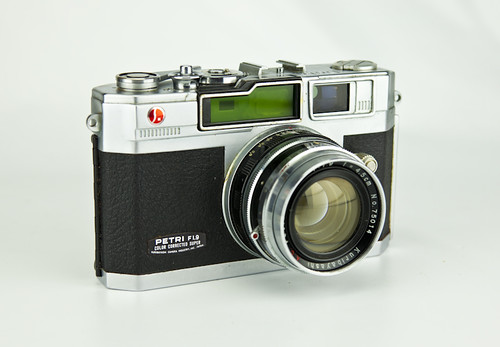
|
| Petri 1.9 Color Super image by Christopher Robin Roberts (Image rights) |
Notes
- ↑ User's manual for the Petri 35 at Mike Butkus' Orphan Cameras
- ↑ 2.0 2.1 2.2 McKeown, James M. and Joan C. McKeown's Price Guide to Antique and Classic Cameras, 12th Edition, 2005-2006. USA, Centennial Photo Service, 2004. ISBN 0-931838-40-1 (hardcover). ISBN 0-931838-41-X (softcover). p579.
- ↑ Petri Automate at Range Finder; text in Japanese, with a few pictures.
- ↑ User's manuals for the Petri 2.8 and the Petri 1.9, at Mike Butkus' Orphan Cameras.
- ↑ For more information please see the Self Timer page.
Links
- Petri 1.9 user manual at Butkus.org
- Petri Color 35 PDF manual at OrphanCameras.com
- Petri Color 35e PDF manual at Butkus' OrphanCameras.com
- Petri PDF camera manuals (45 of them) listed on this site at Butkus's OrphanCameras
- Petri 2.8 Color Corrected Super at photoethnography.com
- Petri 2.8 Color Super at Sylvain Halgand's Collection d'Appareils (in French)
- Entries in petri @ ウィキ (petri@wiki; text in Japanese):
